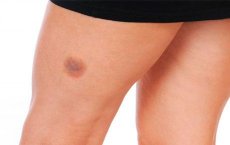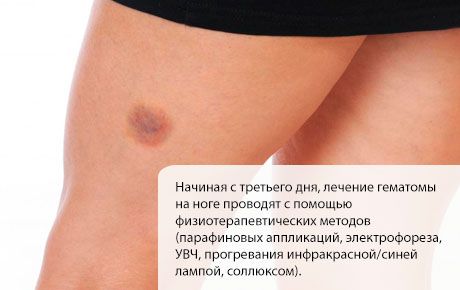Medical expert of the article
New publications
Treatment of a hematoma on the leg
Last reviewed: 06.07.2025

All iLive content is medically reviewed or fact checked to ensure as much factual accuracy as possible.
We have strict sourcing guidelines and only link to reputable media sites, academic research institutions and, whenever possible, medically peer reviewed studies. Note that the numbers in parentheses ([1], [2], etc.) are clickable links to these studies.
If you feel that any of our content is inaccurate, out-of-date, or otherwise questionable, please select it and press Ctrl + Enter.

The result of a closed injury to the leg (due to a bruise, fall, compression, injury, etc.) with rupture of blood vessels and accumulation of blood (liquid or clotted) in the surrounding tissues is a hematoma.
The time it takes for a bruise to appear directly depends on its depth. For example, damage to the skin and fatty tissue appears instantly. Deeper damage is detected the next day or the day after the injury. The color of the hematoma can be used to judge its age. A fresh mark has a reddish tint, which gradually changes to crimson, and after three days it turns blue. A weekly hematoma becomes green, then yellow and gradually dissolves.
The treatment prescribed for a hematoma on the leg will depend on the severity of the injury:
- degree – only the skin is affected, the pain disappears on the 2-3 day;
- degree - there is a rupture of muscle structures, swelling. The injury occurs with severe pain syndrome and a general deterioration in well-being;
- degree – tendons and muscles are involved in the process, joint dislocation is possible;
- degree – limb mobility is limited or completely absent.
The presence of a reaction from the body in the form of temperature is a normal phenomenon on the second or third day after receiving an injury, indicating a massive absorption of bruise products.
Treatment of hematoma on the leg in most cases is passive. An ice compress is applied to the affected area for 20 minutes and fixed with a tight bandage. The procedure is repeated twice, ensuring complete rest of the injured limb. To relieve pain, take "analgin", "ibuprom". If necessary, ointments (heparin, troxevasin gel) with resolving and tonic properties are indicated. The proximity of the hematoma to an extensive tumor may be a reason for performing a puncture (removal of spilled blood). Opening the hematoma is also recommended in case of severe pain and a large bruise.
Treatment methods for hematoma on the leg
Localization of a large hematoma in the lower limb area may be accompanied by severe pain; sometimes it is more appropriate to open it in a surgeon’s office in order to prevent the formation of pus and the attachment of connective tissue to the pathological focus.
Surgical methods of treating a hematoma on the leg are indicated when the hematoma volume increases and there is pulsating pain in the area of the bruise. Especially when a lot of time has passed since the injury.
If a minor leg injury has occurred and you are taking analgesics for pain relief, then there is no need to worry. The use of drugs such as aspirin, aspecard, warfarin and cardiomagnyl, the need for injections of clexane, heparin, fraxiparin will be a reason to contact a therapist and have a blood test (general plus coagulation). Often such a patient is referred for liver function tests. Therapeutic intervention is prescribed by a doctor based on laboratory tests, visual examination and patient complaints.
Most methods of treating a hematoma on the leg come down to:
- forced rest;
- applying ice two to three times a day for 20 minutes;
- applying a pressure bandage.
In the first days after the injury, do not take a hot shower/bath, avoid drinking alcohol, so as not to increase swelling. On the third day, you can warm up the bruise with a warm heating pad, and also massage the damaged area to restore blood circulation and speed up resorption.
Starting from the third day, treatment of hematoma on the leg is carried out using physiotherapeutic methods (paraffin applications, electrophoresis, UHF, warming with an infrared/blue lamp, sollux).
It is imperative to consult a specialist if:
- the location of the hematoma near a joint that has significantly increased in size, become inflamed, and there is a loss of mobility;
- pulsation is expressed;
- the hematoma continues to grow two hours after the injury;
- The victim complains of fever, weakness, nausea, and the pain at the site of the injury intensifies.
Treatment of hematoma of the lower leg
Treatment of a small-sized shin hematoma is carried out using conservative methods. Treatment of a shin hematoma requires surgical intervention when pus forms in the affected area, pain increases, the hematoma increases in volume, and the body's temperature response increases. Physiotherapy procedures, gels, and ointments are prescribed to eliminate the hematoma.
Lioton gel is rubbed into the affected area one to three times a day in an amount of three to ten centimeters of gel.
Troxevasin gel is used twice a day, rubbing the required amount of the substance into the hematoma formation site with massage movements until it is completely absorbed. When an encapsulated hematoma of the shin is formed, when the blood is not absorbed into the tissues, but forms clots, surgery is required. During surgical treatment of a hematoma of the shin, the patient is given local anesthesia, a small incision is made in the skin through which blood clots are removed by squeezing, after which the affected area is treated with hydrogen peroxide and drainage is done. Before treating the hematoma, the patient may be prescribed an ultrasound examination.
Treatment of hip hematoma
Treatment of a hip hematoma can be carried out independently only if the damage is minor and not accompanied by a general deterioration in health, temperature reaction, or severe pain.
After a hip injury and the development of a hematoma, ice can be applied to the affected area, after which the sore spot can be secured with a tight bandage.
After five to six days, warming of the affected area with a blue or IR lamp may be prescribed. When treating a hip hematoma, it is advisable to limit the load on the affected leg.
Treatment of a hip hematoma includes local application of ointments and gels that help relieve inflammation, reduce pain and swelling. These include troxevasin gel, lyoton gel, dolobene gel and others. Dolobene gel is applied to the damaged area at a rate of approximately 3 cm of gel per ten centimeters of skin (the size of the kneecap), after which it is rubbed in with light movements until completely absorbed. The procedure is performed two to four times a day.
It is necessary to consult a doctor if the hematoma is large, swelling increases, bones or joints are damaged, the affected area becomes infected, or the temperature rises.
In complicated cases, treatment of a hip hematoma may be surgical. Magnetic resonance imaging and ultrasound examination are performed to determine the advisability of surgical intervention. During the operation, a small incision is made at the site of injury; if blood clots form, they are removed by squeezing.
Folk treatment of hematoma on the leg
Among natural recipes, a popular treatment for a hematoma on the leg is a compress based on a sponge (1 tablespoon of dry mixture purchased at a pharmacy, diluted with 2 tablespoons of water), which is applied to the bruise at least three times a day.
Herbalists recommend applying aloe leaves with honey to the site of the hemorrhage during the first few days, and when the condition stabilizes on the third day, begin warming the bruise.
Folk treatment of hematoma on the leg could not do without healing clay. Moreover, its color and place of collection do not matter. The clay is brought to the consistency of sour cream, rolled out into a cake, which is applied to the injured area of the skin, a cotton cloth is placed on top and the bandage is insulated with oilcloth. The clay is kept for two hours. Repeated use of clay is not recommended.
The pharmaceutical balm "bishofite" works wonders with the largest hematomas, resolving them in a week. Lotions are made from a solution of "bishofite" and water in proportions of 1:2.
A mixture of honey, castor oil and wormwood herb is used to make something similar to an ointment, which is applied twice a day for 15 minutes. Unfortunately, this composition does not have an analgesic effect.

Crushed fresh plantain leaves have analgesic and anti-inflammatory properties, and common salt helps to quickly get rid of a bruise. Treatment of a hematoma on the leg with a salt compress (10 g of salt per half a glass of water) disinfects the wound surface, relieves pain and removes dead cells. The bandage is secured with a bandage or scarf.
Bruises are treated with an infusion of wild rosemary flowers or a decoction, for the preparation of which you will need 2 tablespoons of dry raw materials and 200 ml of water. The mixture is boiled over low heat for 15 minutes, then filtered.
Folk treatment of a hematoma on the leg is indicated for a mild form of bruise, as well as after consultation with a specialist.
Treatment of internal hematoma on the leg
The location of the internal hematoma is muscles, subcutaneous tissue. Hemorrhage into the injured area on the leg is accompanied by pain, severe swelling, skin discoloration, dysfunction of muscle structures, and often fever.
Treatment of internal hematoma on the leg consists of removing blood by puncture. If there is a bleeding vessel, the hematoma is opened, the blood is evacuated, and then the integrity of the damaged bloodstream is restored. In some cases, drainage of the hematoma is required.
Hematomas with pain and pulsation, a large area of subcutaneous bruising, as well as those located near a joint require seeking medical attention.
Treatment of hematoma on the leg with ointments
Good regeneration and pain relief at the same time are provided by the emulsion "riciniol" provided that the damaged area of skin is treated immediately after the injury. The use of this product can minimize or completely eliminate the appearance of a hematoma.
Treatment of hematoma on the leg with ointments is indicated on the second day after injury. Most often, absorbable agents are used - "Lioton" gel, ointment based on heparin and "Troxevasin". Medicinal substances are applied - 3 times a day in a thin layer, without rubbing into the skin. The therapeutic effect is achieved in 3-7 days. From homeopathy, "arnica" shows the best results due to wound-healing, anti-inflammatory effects. The substance is applied two or three times a day in a thin layer for up to 14 days.
In case of local temperature increase, i.e. skin of the damaged area, and increase of pain syndrome, relief is provided by non-steroidal anti-inflammatory ointments - "fastum-gel", "nimesil", "diclak" and "ketonal". It is advisable to lubricate the hematoma with them up to 4 times a day for a course of 7-10 days. Treatment of hematoma on the leg with these drugs increases capillary resistance, reduces permeability of blood vessels, has a tonic effect on the muscles of the venous walls.
Rapid healing is also provided by the "comfrey" ointment, which includes antiseptic tea tree oil. The "rescuer" balm has high regenerative activity, which is explained by its components - esters, beeswax, sea buckthorn oil and vitamin complex.
Treatment of a hematoma on the leg should be based on the symptoms, so if there is severe pain, acute pulsation and swelling, it is better not to self-medicate, but to immediately seek qualified help.


 [
[